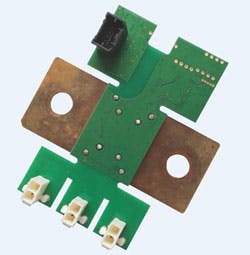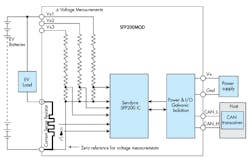Critical to the operation of any electric vehicle (EV) is the energy stored in its battery, which determines the distance it can travel. The amount of charge stored in the battery is measured in coulombs or ampere-hours, with the total energy usually measured in watt hours. Determining the amount of energy available in a battery is a complex task because battery age, discharge current, and temperature all impact battery capacity. To accommodate this energy measurement complexity, EVs employ a sophisticated battery management system (BMS) to continuously monitor battery condition.
A BMS must be able to predict accurately the state of the battery system. These predictive capabilities are only as accurate as the information on which they are based. Accurate current measurement is a necessary function of any BMS. Hall Effect devices have been used for current measurement, but they are prone to errors caused by neighboring electronic systems.
Measuring current with a conventional resistive shunt is not affected by their environment but can produce measurement errors. A shunt with a high resistance can measure small currents, but can overheat and consume significant energy when dealing with high currents. If the shunt has a low resistance, it may be able to measure high currents accurately, but may not be able to distinguish signal from noise in smaller currents. In addition, when measuring microvolt level signals, you must compensate for the thermoelectric potential differences in contacts (i.e., the Seebeck effect).
Sendyne’s SFP200MOD battery current and voltage sensing module consists of Sendyne’s low-resistance current shunt and the SFP200 high-precision sensing IC (Fig. 1). This module addresses the unique requirements of electrical energy storage and monitoring of EV batteries. The SFP200 is a digitally assisted analog data acquisition IC with unique circuits tailored specifically to a wide range of current measurements. The IC simultaneously measures bi-directional dc current across a resistive shunt, voltage, and shunt temperature. This IC uses algorithms that compensate for many micro phenomena that affect measurement accuracy. The SFP200 is rated for the –40° C to +125° C automotive temperature range.
Sendyne’s proprietary, patented, and patent-pending “Continuous Calibration” technology allows the IC to compensate for thermal drifts including those arising from external interface circuitry such as EMI/RFI/anti-aliasing filters. The IC provides internally accumulated coulomb counting information, accurate voltage measurement with a flexible range, and accurate temperature sensing using inexpensive external thermistors. The SFP200 communicates with the Controller Area Network (CAN) controller.
The SFP200MOD is an automotive-grade precision module capable of measuring currents from mA up to 500A continuously and with 1000A peaks for 5 seconds. The module incorporates an 18µΩ shunt, which achieves better than ±1.0% accuracy (typically ±0.5%) over its entire -40° C to 125° C operating range. The output of this module is digital, so it can communicate directly with a BMS without the need for analog-to-digital conversion. There is built-in calibration for current and voltage measurements.
This module simultaneously measures bi-directional dc current through its 18 µΩ shunt and three high-voltage channels (800 nominal, 1000/channel max), as well as providing battery condition outputs. The module provides automatic temperature compensation for shunt resistance.
Figure 2 is an application diagram showing the input and output interfaces for the SFP200MOD. The CAN bus interface consists of isolated CAN 2.0B signals operating at 500 kbits/s.
CAN is a vehicle bus standard that allows microcontrollers and devices to communicate with each other over significant distances in electrically-noisy environments. CAN 2.0B is a message-based protocol that uses 29-bit identifiers. It achieves noise immunity by maintaining the differential impedance of the bus at a low level with low-value resistors (120 Ω) at each end of the bus.
The values of current, voltage, shunt temperature, and coulomb count are stored in registers mapped in memory space, which are accessed one at a time over a CAN interface. The host computer can access the registers by polling them. All data returned by the SFB200MOD is in a 32-bit signed integer format (2’s complement signed data). 64-bit Coulomb counts are split into two registers: coulomb count high and coulomb count low.
You can power the SFP200MOD with a +5 to 48V supply without any modifications or adjustments. Power consumption is less than 350 mW.
About the Author

Sam Davis
Sam Davis was the editor-in-chief of Power Electronics Technology magazine and website that is now part of Electronic Design. He has 18 years experience in electronic engineering design and management, six years in public relations and 25 years as a trade press editor. He holds a BSEE from Case-Western Reserve University, and did graduate work at the same school and UCLA. Sam was the editor for PCIM, the predecessor to Power Electronics Technology, from 1984 to 2004. His engineering experience includes circuit and system design for Litton Systems, Bunker-Ramo, Rocketdyne, and Clevite Corporation.. Design tasks included analog circuits, display systems, power supplies, underwater ordnance systems, and test systems. He also served as a program manager for a Litton Systems Navy program.
Sam is the author of Computer Data Displays, a book published by Prentice-Hall in the U.S. and Japan in 1969. He is also a recipient of the Jesse Neal Award for trade press editorial excellence, and has one patent for naval ship construction that simplifies electronic system integration.
You can also check out his Power Electronics blog.



